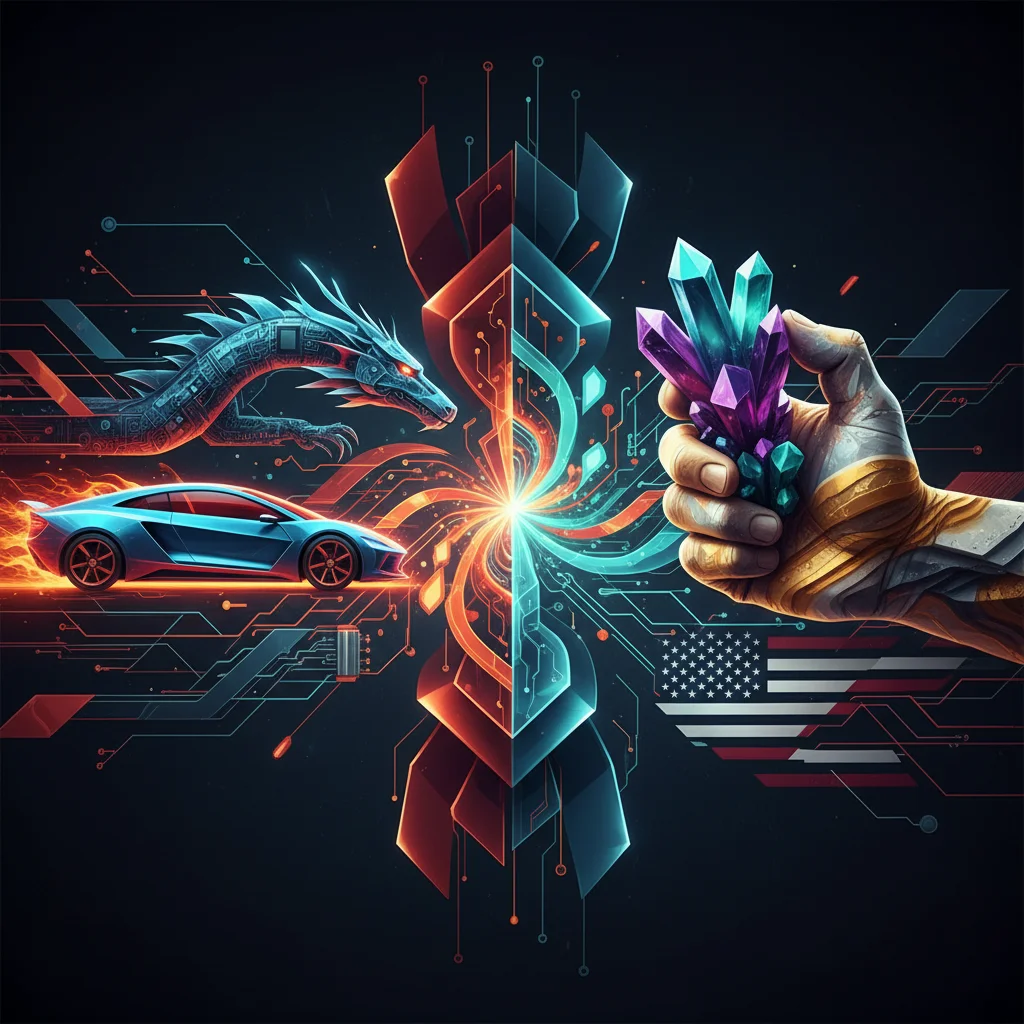
The New Tech Arms Race: Inside China’s EV Blitz and the US Scramble for Critical Minerals
Grab a coffee and settle in, because we need to talk about the tectonic plates of technology shifting beneath our feet. On the surface, the headlines might seem disconnected: a massive funding surge for Chinese automakers here, a frantic American push for rare minerals there. But when you look closer, these aren’t separate stories. They are two fronts in the same silent, high-stakes war for the future of technology, manufacturing, and global influence.
This isn’t a battle fought with tanks and jets. It’s a strategic chess match where the key pieces are silicon chips, lines of programming code, and control over the very elements that power our digital world. The latest dispatches from Nikkei Asia and the Financial Times paint a vivid picture of this new reality. China is doubling down on finished products, particularly electric vehicles (EVs), while the U.S. is waking up to a critical vulnerability at the very beginning of the supply chain: rare earth elements. Let’s break down what’s happening and, more importantly, why it matters to everyone in the tech ecosystem—from developers and entrepreneurs to investors and strategists.
China’s Electric Gambit: More Than Just Cars, It’s a Software-Defined Future
When we talk about China’s “auto funding blitz,” it’s easy to picture endless assembly lines churning out cars. But that’s a 20th-century perspective. Today’s EV isn’t just a vehicle; it’s a sophisticated, rolling data center. It’s a masterpiece of software, powered by advanced artificial intelligence, and connected to the cloud. And Beijing knows it.
The massive capital injection into its auto sector is a calculated move to dominate not just manufacturing, but the entire tech stack that comes with it. Think about what makes a modern EV company valuable:
- Autonomous Driving: This is a pure AI and machine learning challenge. It requires immense data collection, sophisticated algorithms, and powerful onboard computers. Companies that lead here will own the future of mobility.
- In-Car Experience: The dashboard is the new app store. From navigation to entertainment, it’s a platform for recurring revenue through SaaS (Software as a Service) models. The user interface, the responsiveness, and the ecosystem of apps are all differentiators.
- Manufacturing Innovation: Chinese EV factories are marvels of hyper-automation. They leverage robotics and AI-driven process optimization to build cars faster and cheaper than ever before, giving them a formidable competitive edge.
This state-backed push has supercharged a new generation of agile Chinese startups that are now competing head-to-head with legacy automakers. They’re not just building cars; they’re building vertically integrated tech companies that control the hardware, the software, and the user experience. This strategy aims to leapfrog the West in a critical consumer technology category, turning cars into a platform for Chinese technological standards and innovation to be exported globally.
Europe's Titans Assemble: Why Their New Space Alliance is a High-Stakes Bet on Software and AI
The Achilles’ Heel: America’s High-Stakes Rush for Rare Earths
While China builds the house, the U.S. is realizing it doesn’t control the quarry for the foundation stones. The “rare earths” in the headline are a group of 17 metallic elements that are, despite their name, not exceptionally rare in the Earth’s crust. What *is* rare is the ability to mine and process them economically and at scale without significant environmental impact.
And here lies the problem. These elements are non-negotiable ingredients for modern technology. They’re in the powerful, lightweight magnets that spin the motors in EVs. They’re essential for wind turbines, smartphones, and critical defense systems. For decades, the world has outsourced this messy, complex processing work, and one country was more than happy to take it on: China.
The result is a staggering level of supply chain dominance. As the U.S. and its allies push for a green transition and re-shore advanced manufacturing, they’re hitting a wall. You can’t build a domestic EV industry if another nation can turn off the tap for the magnets that make them run. The recent U.S. “rush for rare earths” is a belated, urgent attempt to correct this strategic blunder (source).
To understand the scale of this dependency, let’s look at the numbers. China doesn’t just mine the most rare earths; it utterly dominates the complex, multi-stage processing required to make them usable.
| Supply Chain Stage | China’s Global Share | Implication |
|---|---|---|
| Mining & Extraction | ~60-70% | Controls the initial source of raw materials. |
| Separation & Refining | ~85-95% | This is the critical choke point. Raw ores are useless without this step. |
| High-Performance Magnet Production | >90% | Controls the manufacturing of the final key component for EVs and defense. |
This isn’t just a trade imbalance; it’s a critical national security issue. The race is now on to build new, non-Chinese supply chains. This involves massive investment in domestic mining, but more importantly, it requires innovation. We’re seeing startups emerge that are focused on new, cleaner extraction technologies and recycling methods. Securing these new industrial assets also brings a massive cybersecurity challenge, as they will undoubtedly become prime targets for industrial espionage and disruption.
The AI Tutor Will See You Now: How AI is Revolutionizing Corporate Training
What we’re witnessing is a geopolitical struggle for control over the “full stack” of 21st-century industry. It’s not enough to design the best AI algorithms or write the cleanest code if you don’t control the silicon it runs on and the raw materials used to make that silicon. Conversely, controlling the raw materials is of limited value if you can’t translate that into market-leading consumer products.
China’s strategy has been a masterclass in vertical integration on a national scale. They moved from low-cost manufacturing to dominating mid-stream processing (like rare earths) and are now aggressively pushing into the high-value, consumer-facing top layer with brands and platforms (like EVs and TikTok). The U.S. and its allies, long focused on the top of the stack—software, SaaS, and platform design—are now scrambling to rebuild the foundations they let erode.
For tech professionals and entrepreneurs, this bifurcation creates both risks and immense opportunities. The risk is a fragmented global market with competing technical standards. The opportunity lies in solving the new problems this creates. Think of the startups that will be born to provide secure, transparent supply chain tracking using blockchain. Think of the AI-driven platforms needed to optimize new mining operations or the cybersecurity firms that will protect this new critical infrastructure. This isn’t just about geopolitics; it’s the starting gun for a new wave of deep-tech innovation.
The Wider Battlefield: From Cars and Mines to Code and Chips
The EV and rare earth conflict is a microcosm of a much broader technological competition. The same dynamics are playing out across every critical sector that will define the coming decades. This is a long-term strategic game where dominance in one area creates leverage in others.
The U.S. CHIPS Act, for example, is a direct response to this reality, aiming to bring semiconductor manufacturing back to American soil. Why? Because advanced AI and machine learning models are useless without the cutting-edge chips to train and run them. According to reporting, both nations see leadership in semiconductors as a non-negotiable prerequisite for economic and military security in the 21st century.
Let’s map out the key arenas of this competition:
| Technology Arena | China’s Strategic Goal | U.S. Strategic Goal |
|---|---|---|
| Semiconductors | Achieve self-sufficiency and break dependency on Western technology (e.g., SMIC). | Maintain a technological lead in chip design and re-shore advanced manufacturing (e.g., CHIPS Act). |
| Artificial Intelligence | Become the world’s primary AI innovation center by 2030, leveraging massive datasets. | Lead in foundational model research and ensure AI development aligns with democratic values. |
| Quantum Computing | Leapfrog current technology to achieve breakthroughs in computing and cryptography. | Fund fundamental research to maintain a lead in a potentially paradigm-shifting technology. |
| Biotechnology | Dominate gene-editing and pharmaceutical production through state-led initiatives. | Foster private-sector innovation in areas like mRNA and personalized medicine. |
Ultimately, the most valuable resource in this competition isn’t a mineral or a machine—it’s human talent. The global battle for top-tier programming, engineering, and research talent is fiercer than ever. The future will be written by the developers, data scientists, and engineers who can build the next generation of software and hardware systems.
The Code to Continuous Learning: Why Your Tech Team's Best Teacher Is… Each Other
What This Means for You: Navigating the New Tech World Order
So, why should a developer in Austin, a startup founder in Berlin, or a product manager in Bangalore care about Chinese auto funding and American mining policy? Because these macro trends are defining the landscape you will be working in for the rest of your career.
Here are the key takeaways:
- Supply Chains are Now a Tech Problem: The era of “fire and forget” global supply chains is over. Resilience, transparency, and security are paramount. This creates a massive opportunity for software, SaaS, and automation solutions that can map, manage, and secure complex global networks.
- Deep Tech is Back: For a while, the tech world was dominated by consumer apps and social media. Now, the hard problems are back in focus. Materials science, robotics, advanced manufacturing, and energy are where the next trillion-dollar companies will be built.
- Cybersecurity is Everything: As nations re-shore critical industries, from chip fabs to refineries, these facilities become high-value targets. The demand for sophisticated cybersecurity solutions to protect operational technology (OT) and industrial control systems (ICS) will explode.
The world is splitting into distinct technological spheres of influence. Navigating this new terrain will be challenging, but for those who understand the underlying currents, the opportunities for innovation are boundless. The game is afoot, and the rules are being written in real-time. The question is, are you ready to play?


